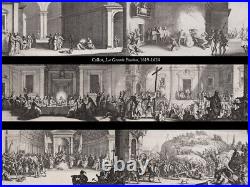

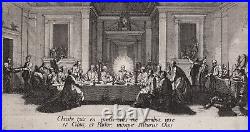
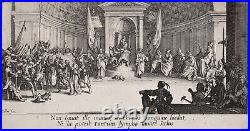
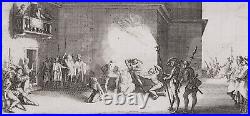
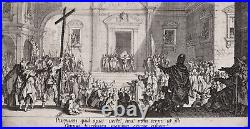
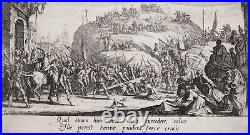
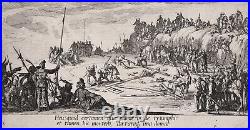
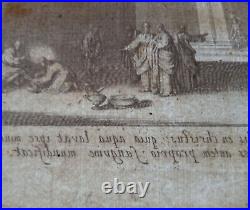



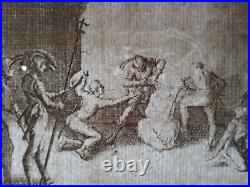



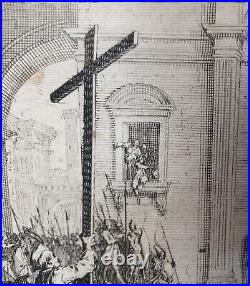
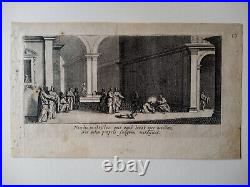
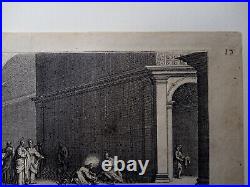
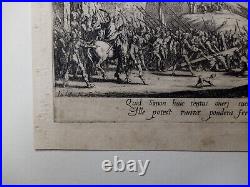


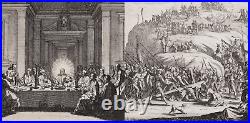
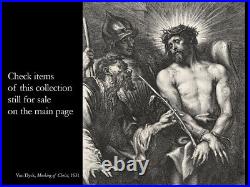
I’m taking over a family collection held in Paris, mostly of works from the French, Flemish and Dutch Golden Age schools of the classical age; on this page, you can discover the items of this collection still for sale. Authenticity – Works for sale are not reproductions, but originals from the 17. All printed on ancient laid paper with the copper plate engraved and signed by the artist. This is the full set of the seven engravings of Callot’s Grande Passion, all printed on 17. Antique laid paper, all with a watermark (except for 281), each time the earliest known state with the lettering, plus the unfinished draft of Callot himself for the Crowning of Thorns. See below for full details. History of the series. Unlike many of the religious works done by Callot, The Large Passion was not commissioned; at a certain point, Callot himself turned to the subject. [.] He undoubtedly felt himself a part of the tradition of the great German and Dutch Passions (Dürer, Altdorfer, van Leyden) and wanted to emulate their legacyRussell, Religious Prints and Drawings of Callot, p. The original series should have been made of 14 prints, and 13 original preparatory drawings have been preserved (all but the Last Supper). Only seven plates were actually completed, and Callot left the Crowning of Thorns unfinished. There is still debate among historians on why Callot stopped the completion of this set. Russell draws from Félibien the following idea: since Dürer, Leyden, Goltzius. Had all used a vertical format for their Passion(s), Callot opted for a provocative horizontal setting which he probably considered more modern, because in these plates, Christ himself is a small figure, often placed far back in the pictorial space. He does not dominate events but is a single, lonely figure amidst huge crowds; his martyrdom is seen as a series of inexorable events taking place in an anonymous milieu of officials, soldiers and onlookersibid. In a sense, Callot tried to apply to the Passion a baroque scenery à la Tentation de Saint-Antoine, and realized afterwards that it wasboth technically challenging (especially, as Félibien underscored, in terms of shading and lighting) and risqué from a religious standpoint, because Jesus, Mary and the Apostles were drowned into the general setting. Although, it remained unfinished, the series is seen as a pivotal moment in the emergence of Classicism as a distinctive style, especially through its influence of Poussin’s Seven Sacraments. 281/II – Le Lavement des pieds [Jesus Washes His Disciples' Feet]. Condition report: Sharp impression; no detail erased or blurred (the window below the first arch on the left still well visible) / Very good condition but for minor stains (a whitening under the first arch on the left, which seems to be common to all impressions except the first state) /6mm margins minimum / Lettering: »Humilis en Christus: quia aqua lavat ipse ministros, / Nos autem proprio sanguine mundificat »; Handwriting: numbered 18 on top right margin with a quill. Authenticity report: On off-white ancient laid paper, without visible watermark / 2. State (Lieure & Meaume), after the lettering (the 1st state, before thelettering is « très rare » says Meaume), but before the upper edgebeing redrawn (« Dans le troisième état, le trait carré supérieur, devenu faible dans le second état, a été renforcé, surtout vers le milieu et à l’angle droit du haut », Meaume). 282/I- La Cène [The Last Supper]. Condition report: Sharp impression; no detail erased or blurred / Very good condition butfor minor stains (traces of bur in the bottom left margin and the top right corner, common to most first states) / 6mm margins minimum / Lettering: « Christe tuis en pascis oves hic carnibus ipse / et cibus, et pastor, moxque futurus ovis »; Handwriting: numbered 21 on top right margin with a quill. Authenticity report: On off-white ancient laid paper, with watermark of the double-C of Lorraine « Lieure note que les meilleures épreuves du premier état sont tirées sur dupapier lorrain au filigrane du double C » Choné, p. State (Lieure & Meaume), before Israël Silvestre added its mark; Silvestre inherited Callot’s plates in 1661. 283/I- La Condamnation à mort [Pilate Washing His Hand]. Condition report: Sharp impression; no detail erased or blurred (except the « u » of « Nulla ») / Very good condition but for minor stains / 6mm margins minimum /Lettering: Non lavat ille manus, sed Christi sanguine foedat. / Nulla postest tantum lympha lavare scelus; Handwriting: numbered 23 with a quill on top right margin. Authenticity report: On off-white ancient laid paper, with watermark of thedouble-C of Lorraine / 1. State (Lieure & Meaume), before « Callot fecit » removed. 284/I-II- Le Couronnement d’épine [The Crowning of Thorns]. Condition report: Good impression; the face of Jesus fully visible, but the arch in the background partially blurred / Very good condition but for minor stains and traces of humidity on the top right corner / 1mm margin. Authenticity report: On off-white ancient laid paper, with watermark of a hunting horn attached to a crutched cross (found by Del Marmol on documents between 1609 and 1631). State of Meaume, 1. 285/I – La Présentation au peuple [Jesus Before the People]. Condition report: Sharp impression; no detail erased or blurred (background buildings below the arch fully visible) / Very good condition but for minor stains (traces of bur in the margins at the bottom corners) / 6mm margins minimum / Lettering: Purpurea quid opus veste? Num cernis ut illi / Omnia purpureo membra cruore rubent! ; Handwriting: numbered 2. With a quill on top right margin. Authenticity report: On off-white ancient laid paper, with watermark of the double-C of Lorraine / 1. State (Lieure & Meaume), before reworking : « Entr eautres différences, on remarque dans le premier état, les traits perpendiculaires qui traversent l’archivolte de la fenêtre la plus rapprochée de la Croix se prolongent jusqu’à la corniche de cette fenêtre, de manière à former des hachures carrées dans le centre, tandis que, dans le second état, le cintre ne renferme que des traits horizontaux » (Meaume; see photography n°17). 286/II – Le Portement de croix [Jesus Carrying the Cross]. Condition report: Sharp impression; no detail erased or blurred (Jerusalem buildings inthe background wholly visible) / Very good condition but for minor stains (traces of bur in the lower margin) / 6mm margins minimum / Lettering: « Quid Simon huic tentas oneri succedere, solus / Ille potest tantae pondera ferre crucis »; Handwriting: numbered 19 with a quill on top right margin. Authenticity report: On off-white ancient laid paper, with hardly readable monogram watermark / 2. State (Lieure & Meaume), before reworking. 287/I- Le Crucifiement [Jesus Put on the Cross]. Condition report: Sharp impression; no detail erased or blurred / Very good condition but for minor stains (traces of bur in the margin at the bottom corners) / 4mm margins minimum / Lettering: Heu! / Et tamen hic mortem, Tartarag ima domat; Handwriting: numbered 24 with aquill on top right margin, traces of pencil on the cross. Authenticity report: On off-white ancient laid paper, with monogram watermark PW (mentioned by Meaume 0718) / 1. State (Lieure & Meaume), before « Callot invenit » removed.